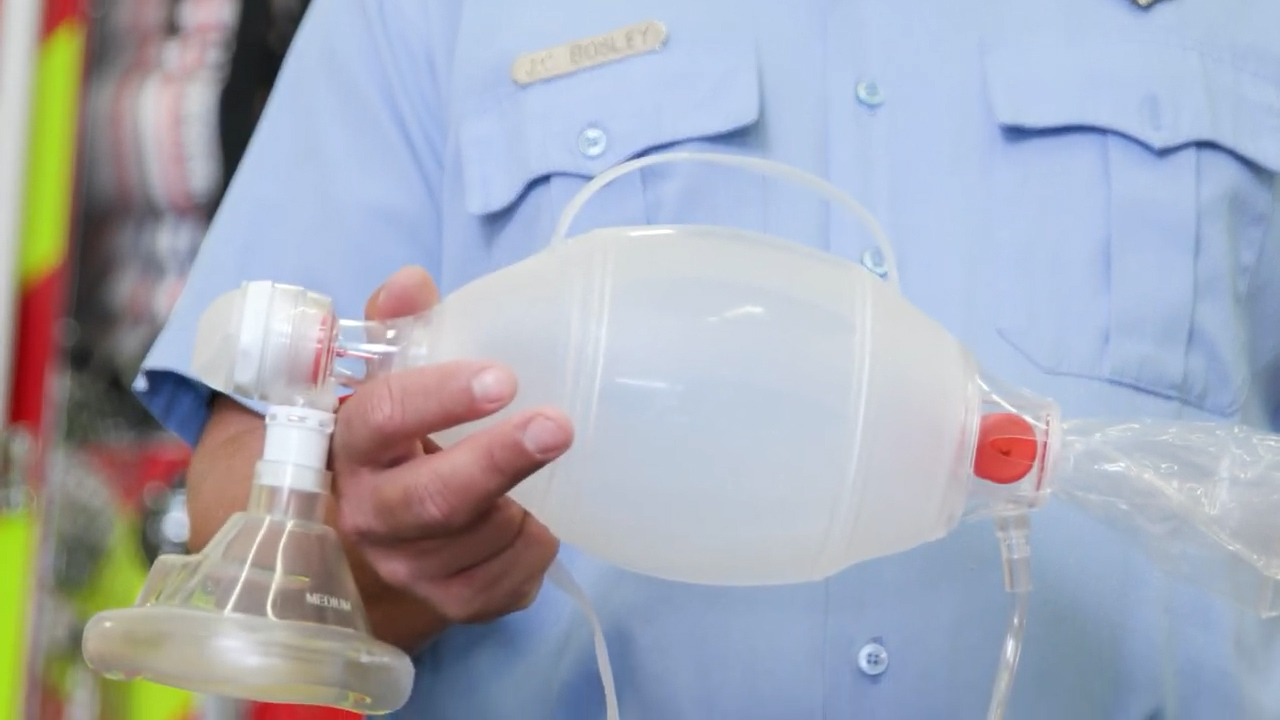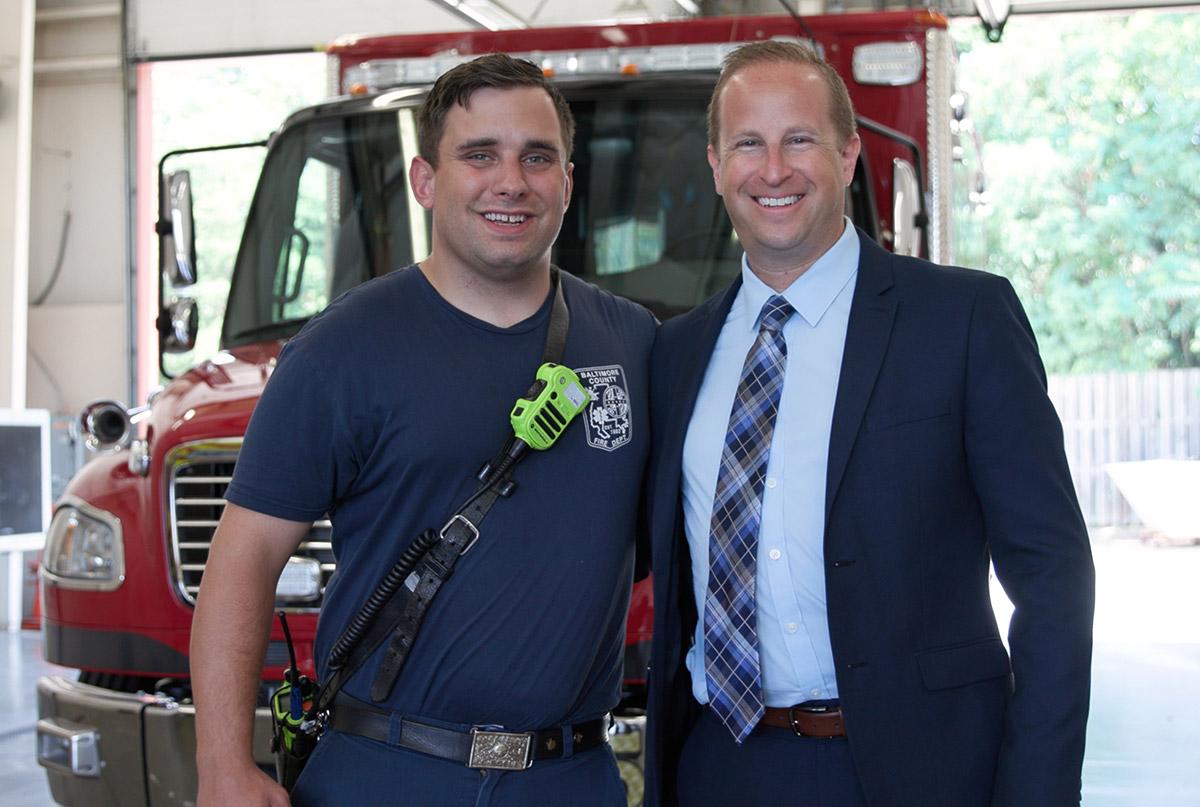'A Lifesaving Tool’
It was a few hours past dusk and threatening cold rain as John Bosley drove the winding S curves of a country road north of Baltimore in his white 2006 Ford 500.
He had attended a viewing for a retired fire chief and was headed to sell Christmas trees at the nearby fire station’s annual sale.
Suddenly, a deer appeared in the middle of the road in front of him.
It was Thursday, November 30, 2017 — the day an Ambu® Bag™ resuscitator would save his life.
The next thing he remembers is waking up in the Shock Trauma Center at the University of Maryland in Baltimore and seeing his mother at the foot of his bed. “Mom, I love you,” were the first words out of his mouth.
Two Strangers Were About to Meet
As Bosley, a third-generation firefighter with Baltimore County Fire Department, drove that night, Dr. David Vitberg was driving too. The strangers had no idea their paths were about to cross. Vitberg, a critical care doctor, had finished a 7 a.m. to 7 p.m. workday at Greater Baltimore Medical Center. The director of the hospital’s medical and surgical ICU was headed home to his wife and three children after his standard 12-hour shift.
Vitberg, a critical care doctor, had finished a 7 a.m. to 7 p.m. workday at Greater Baltimore Medical Center. The director of the hospital’s medical and surgical ICU was headed home to his wife and three children after his standard 12-hour shift.
He turned the key in his black Ford Explorer and the mobile radio automatically crackled to life. The car came with his job as deputy medical director for the Baltimore County Fire Department.
The radio traffic he heard troubled him as he drove out of the parking lot. There was an accident on a rural road that he knew well. It was a treacherous area — a narrow, winding stretch, notorious for bad crashes.
“It was dispatched as a garden-variety, vanilla accident with a bare minimum response call,” he says. “I just had this premonition, a gut feeling: This has the potential to get really bad.”
He headed north, toward the accident, listening intently as the rescue unfolded. No need for sirens and lights, he thought. Not yet.
But soon, dispatchers upgraded the call, asking for more rescue equipment. Vitberg was about 7 minutes into what would be a 14-minute trip to get there. The curves would slow him down the last few miles, so he had to make time while he could.
“I needed to be there,” he says. “I hit the gas pretty hard with lights and siren.”
Luckily the roads were empty as his turbo kicked in, and he reached about 90 mph. Those early minutes after an accident are the difference between life and death.
He arrived to find a volunteer from a nearby fire station standing by the open driver’s side door of a mangled car, looking in. As soon as the firefighter saw Vitberg, he furiously waved him over.
Vitberg jumped out of his SUV, popped the trunk, grabbed his gear, and ran to the car, quickly assessing that his skills were most needed there, although there was another car and victim.
The driver lay across the front seat, partially wedged in the footwell, unconscious and not breathing. Something on his clothing instantly identified him as a firefighter, and the red duffle bag in the back seat that matched his own only confirmed what Vitberg already suspected.
This accident victim was one of his own. He would come to find out that the victim was Bosley.
“You could tell he was in bad shape,” Vitberg says. “It was apparent he had a pretty severe head injury.”
Bosley was “guppy breathing,” the type of gasping breaths that people take as their body fights unsuccessfully for air. There was very little time.
At that point, Vitberg knew a medical helicopter would be needed, and the call was made.
Time For An Ambu Bag He and a firefighter pulled Bosley from the car and put him on a backboard in the middle of Falls Road. Vitberg intubated him using an Ambu Bag, then hooked up a cardiac monitor. By then, additional emergency equipment had arrived and blocked the road.
He and a firefighter pulled Bosley from the car and put him on a backboard in the middle of Falls Road. Vitberg intubated him using an Ambu Bag, then hooked up a cardiac monitor. By then, additional emergency equipment had arrived and blocked the road.
Created in 1956 in Europe by Dr. Holger Hesse and Dr. Henning Ruben, an anesthesiologist, the Ambu Bag has become the standard of care across emergency settings and has helped more than 45 million people breathe in the last 10 years alone.
“The Ambu Bag was incredibly important in his case,” Vitberg says. “Of all the equipment we pulled out that night to treat him, it was the single most important piece of equipment we used. The Ambu Bag is what sustained him and kept his traumatic brain injury from getting worse.”
Ever present in the back of Vitberg’s mind was the classic test question in critical care training: How does the outcome change for a patient with a traumatic brain injury if they have even a single episode of their oxygen saturation dipping below 90 percent?
The answer: Their chance of dying increases 150 percent.
‘Did I Do Enough?’
Vitberg did what he could to stabilize Bosley, then helped get him to the nearby fire station where the rescue helicopter, with its four-person crew, would land. He helped load him aboard the elite Maryland State Police Dauphin helicopter — essentially a critical care suite — for the 7- to 10-minute flight into Baltimore. He waited until the doors were closed before he walked away, watching the helicopter rise into the night.
“There’s this huge swirl of emotion,” he says. “I was worried, very worried. What did I do to help him, and did I do enough?
Bosley knows that the quick call for the helicopter was only one stroke of luck of many he had that night. Things could have gone so differently.
Just as the helicopter lifted off, the rain began. Any sooner and the cloud ceiling would have been low enough to ground flight.
“If the doctor wasn’t there, I probably would have died,” Bosley says. “I would have been pronounced dead at the scene. The Ambu Bag breathed for me.” The power of an Ambu Bag to save his life isn’t lost on Bosley, who uses them routinely as a firefighter.
The power of an Ambu Bag to save his life isn’t lost on Bosley, who uses them routinely as a firefighter.
“It’s a lifesaving tool,” he says, “Me being a first responder, we use an Ambu Bag all the time. It’s just another day in the field. You see it work on other patients and you see it breathing for them, and the next thing you know, it’s you.”
He had dinner with Dr. Vitberg a few months after the accident to thank him. They didn’t know each other before the crash. Bosley now follows the doctor, who helped save his life, on social media.
'The Best Reward of All'
Vitberg describes having all the jitters of a first date that night when he went to meet Bosley for the first time after the accident.
“When I saw John back on his feet, it was the best reward of all,” Vitberg says of that meeting. “I was just so happy for him”
Vitberg had been confident that Bosley would survive because there were so many resources available the night of the accident — but was far less sure of his neurological level of functioning. Returning to the high-performance job of being a firefighter, with its physical rigor and demand for split-second decisions, presented a whole other level of challenge.
Everything went the way it was supposed to that night in terms of Bosley’s care, Vitberg says.
“But on my spiritual side, I think there’s a reason for that that’s greater than us,” he says.

Vitberg has come to the aid of about 50 firefighters in his 10 years with the department and considers that role a particular privilege.
“I feel this is my purpose on this earth,” Vitberg says of his critical care specialty. “It’s exhilarating to be able to perform these high acuity skills in the dark, in the middle of a road. It makes you really appreciate life.”
The accident, which was a head-on collision with another car, set in motion a long recovery. The other driver was not badly injured and was treated and released, Bosley says.
But Bosley broke a C2 vertebrae in his neck, one of the vertebrae that control breathing. He also suffered a collapsed left lung, and a traumatic brain injury. He spent about 18 hours on a ventilator.
After spending two weeks in the trauma unit at the University of Maryland, he moved to the hospital’s rehabilitation unit for another two weeks. He learned to walk all over again using a walker.
He came home Jan. 5, 2018, and started visiting the traumatic brain injury unit at Baltimore’s Sinai Hospital four times a week for months of rehabilitation. He had to re-learn many things, including motor skills and how to think and remember.
Finally, on July 11, 2018, he headed back to work at a fire station — about nine months after his accident.
“I was very happy,’’ he says. “I didn’t think I’d be able to go back to work in that profession because of my deficits from the traumatic brain injury.”
To this day, Bosley, now 26-years-old, has no memory from the end of high school until the time of the accident. Although he has seen pictures, he has no recollection of the marriages of two brothers to their wives, the death of his grandfather, or the birth of his niece.
Work Left to Do
Not a day goes by without Bosley thinking about the accident.
“I’ll just start driving to work, and it’s always in front of me,” he says, his deep green eyes lost in thought. “I think, wow, I’m still here. How did I get afforded a second chance at life?”
Every morning when the six-year veteran firefighter wakes up, he says a silent thank you. He is grateful to be able to go to work at a job he loves, where every day dawns with the opportunity to help people and save lives.
“There is a reason why I’m here, and I don’t know what it is yet, but one of these days it’s going to come to me,” he says. “Obviously I’m here to do something. The stars wouldn’t have lined up that night otherwise. I’m back doing my line of work. Maybe that’s why.”


